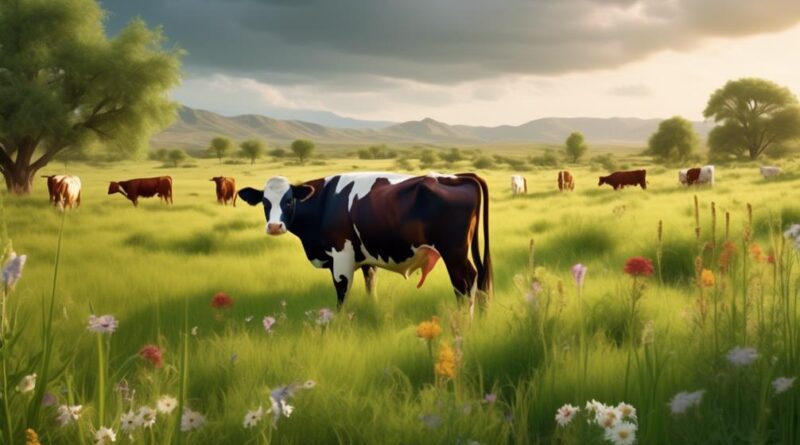Why Biodynamic Forage Is Vital for Cattle Ranching
You may have heard that biodynamic forage is like a well-tuned engine for your cattle ranch, but have you truly considered the depth of its impact?
The benefits of biodynamic forage reach far beyond simply providing sustenance for your herd. As you navigate the complex world of cattle ranching, understanding the vital role that biodynamic forage plays in soil health, nutritional value for cattle, sustainable grazing practices, and environmental impact is crucial for the success and longevity of your operation.
But what exactly makes biodynamic forage so essential for cattle ranching?
Benefits of Biodynamic Forage
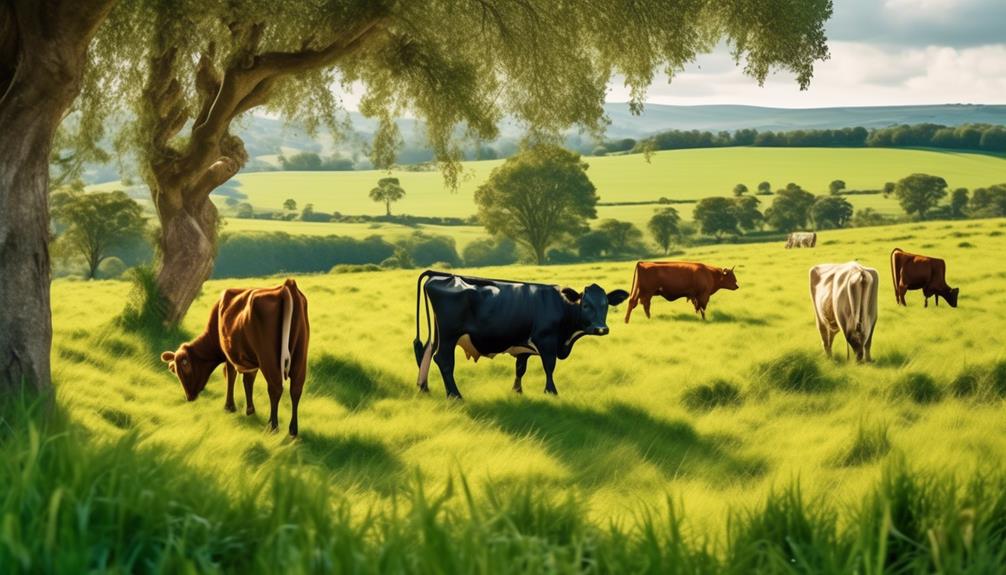
Biodynamic forage offers an array of benefits for cattle ranching, providing nutrient-rich feed while promoting soil fertility and biodiversity. By practicing crop rotation, biodynamic forage helps maintain soil fertility. This technique involves alternating the types of crops grown in a particular area, preventing depletion of soil nutrients and reducing the buildup of pests and diseases. This sustainable approach fosters healthier soil, ensuring the continuous production of high-quality forage for cattle.
Furthermore, biodynamic forage plays a significant role in promoting biodiversity and ecosystem balance. Through the cultivation of diverse plant species, this practice creates a rich and varied habitat for various organisms, including insects, birds, and microorganisms. A balanced ecosystem is vital for the overall health of the ranching environment, as it helps control pests and diseases naturally, reducing the need for chemical interventions.
Additionally, the diverse range of plants contributes to improved soil structure, water retention, and nutrient cycling, further enhancing the sustainability of cattle ranching operations.
Importance of Soil Health
Maintaining optimal soil health is crucial for sustaining the productivity and vitality of your cattle ranching operation. Soil health directly impacts your forage quality, which in turn affects the health and performance of your cattle. Soil fertility, a key component of soil health, is essential for providing the necessary nutrients to your forage crops. By adopting biodynamic practices, you can enhance soil fertility through natural means, promoting the growth of nutrient-rich forage that will benefit your cattle.
Furthermore, soil health plays a significant role in carbon sequestration. Healthy soils have the capacity to store carbon, aiding in the reduction of greenhouse gases in the atmosphere. By prioritizing soil health on your ranch, you contribute to the broader environmental effort to mitigate climate change. Additionally, carbon sequestration in your soil can lead to improved soil structure and water retention, creating a more resilient and sustainable environment for your forage crops.
Incorporating biodynamic forage into your cattle ranching operation not only enhances the nutritional value of the feed for your cattle but also contributes to the overall health of your soil. By nurturing soil fertility and promoting carbon sequestration, you're investing in the long-term productivity and sustainability of your ranching enterprise.
Prioritizing soil health is a proactive approach that will benefit both your cattle and the environment.
Nutritional Value for Cattle
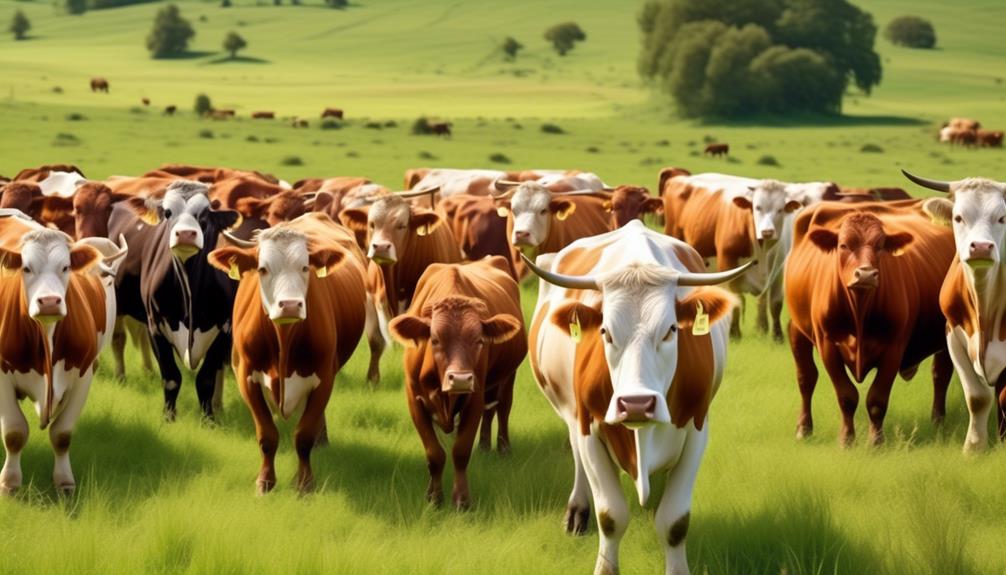
Enhancing your cattle's nutrition starts with understanding the direct link between soil health and the quality of your forage crops. Biodynamic forage offers superior nutritional value for your cattle, providing optimal protein content and energy levels essential for their growth and well-being.
The protein content in biodynamic forage is particularly crucial as it directly impacts your cattle's muscle development, immune function, and overall health. Additionally, the high energy levels in biodynamic forage ensure that your cattle have the necessary fuel for their daily activities and metabolic processes.
Moreover, biodynamic forage boasts exceptional digestibility and palatability, making it easier for your cattle to extract essential nutrients from their feed. Improved digestibility means that more nutrients are available for absorption, leading to better overall health and productivity in your herd.
Furthermore, the palatability of biodynamic forage ensures that your cattle eagerly consume their feed, reducing the likelihood of nutritional deficiencies and promoting consistent growth and weight gain.
Sustainable Grazing Practices
To ensure the long-term health of your cattle and the land, sustainable grazing practices play a vital role in maintaining a balanced ecosystem. Implementing effective grazing strategies not only benefits your cattle but also promotes the overall health of the pasture and surrounding environment. Here are some key sustainable grazing practices that are essential for the well-being of your cattle and the land:
- Grazing Rotation: Regularly rotating your cattle to different pasture areas helps prevent overgrazing and allows the vegetation to recover. It also promotes more uniform grazing across the entire pasture, preventing the depletion of specific plant species. This practice encourages healthier plant growth and reduces soil erosion, ultimately contributing to a more sustainable and resilient ecosystem.
- Biodiversity Management: Managing the diversity of plant species in your pastures is crucial for maintaining a balanced ecosystem. Encouraging a variety of plants promotes soil health, reduces the risk of disease outbreaks, and provides a more nutritious forage for your cattle. By supporting a diverse range of plant species, you can create a more resilient and adaptable environment for your cattle to thrive.
- Infrastructure Development: Investing in infrastructure such as water systems, fencing, and shade structures can help manage grazing areas more effectively. Well-designed infrastructure facilitates controlled grazing, prevents soil compaction, and ensures proper distribution of cattle across the pasture, contributing to the long-term sustainability of your grazing operations.
Enhancing Cattle Well-being
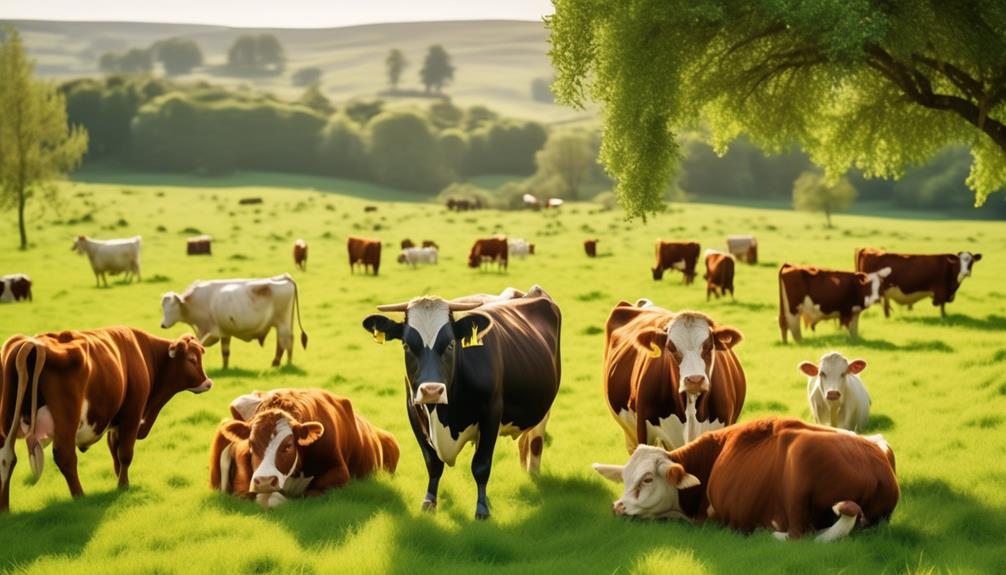
As you strive for a balanced ecosystem and sustainable grazing practices, ensuring the well-being of your cattle is paramount for the overall health of your ranching operations. Cattle nutrition plays a pivotal role in enhancing the well-being of your herd. Providing a well-balanced diet is essential to keep your cattle healthy and productive. Biodynamic forage, rich in essential nutrients, can significantly contribute to meeting your cattle's nutritional needs. By integrating biodynamic forage into your pasture management, you can ensure that your cattle have access to high-quality, nutrient-dense feed, promoting their overall well-being.
In addition to focusing on cattle nutrition, effective pasture management is crucial for enhancing the well-being of your cattle. Providing ample grazing space and maintaining the pasture's health through sustainable practices can directly impact the welfare of your herd. Rotational grazing, for example, allows forage to recover and ensures that cattle have access to fresh, high-quality grass, promoting both physical health and mental well-being. Furthermore, implementing sustainable pasture management techniques can help prevent overgrazing and soil degradation, creating a healthier environment for your cattle to thrive in.
Ultimately, prioritizing cattle nutrition and implementing effective pasture management strategies are integral to enhancing the well-being of your herd. By providing nutritious forage and maintaining a sustainable grazing environment, you can ensure that your cattle aren't only healthy but also content, contributing to the overall success of your ranching operations.
Environmental Impact of Biodynamic Forage
The use of biodynamic forage can have a significant impact on the environment, promoting soil health and biodiversity while reducing the need for synthetic inputs. By choosing biodynamic forage for your cattle ranching operation, you're contributing to a more sustainable and eco-friendly approach that benefits both your livestock and the environment.
Here are some key environmental impacts of biodynamic forage:
- Reduced Carbon Footprint: Biodynamic forage production methods prioritize the use of natural fertilizers and compost, reducing the reliance on synthetic chemicals that contribute to greenhouse gas emissions. This approach helps to minimize the carbon footprint of your cattle ranching operation, aligning with global efforts to combat climate change.
- Biodiversity Conservation: Biodynamic forage cultivation encourages the preservation of diverse plant species, which in turn supports a variety of beneficial insects, birds, and other wildlife. This approach fosters a more balanced and resilient ecosystem on your ranch, promoting biodiversity conservation and creating a healthier environment for your cattle.
- Soil Health Improvement: Biodynamic forage practices focus on enhancing soil fertility and structure through organic methods such as crop rotation, cover cropping, and composting. These techniques promote soil health, water retention, and nutrient cycling, ultimately contributing to the long-term sustainability of your ranching land.
Incorporating biodynamic forage into your cattle ranching operations not only benefits your livestock but also plays a crucial role in reducing the environmental impact of your agricultural practices, ensuring a more sustainable future for both your business and the planet.
Seasonal Forage Management
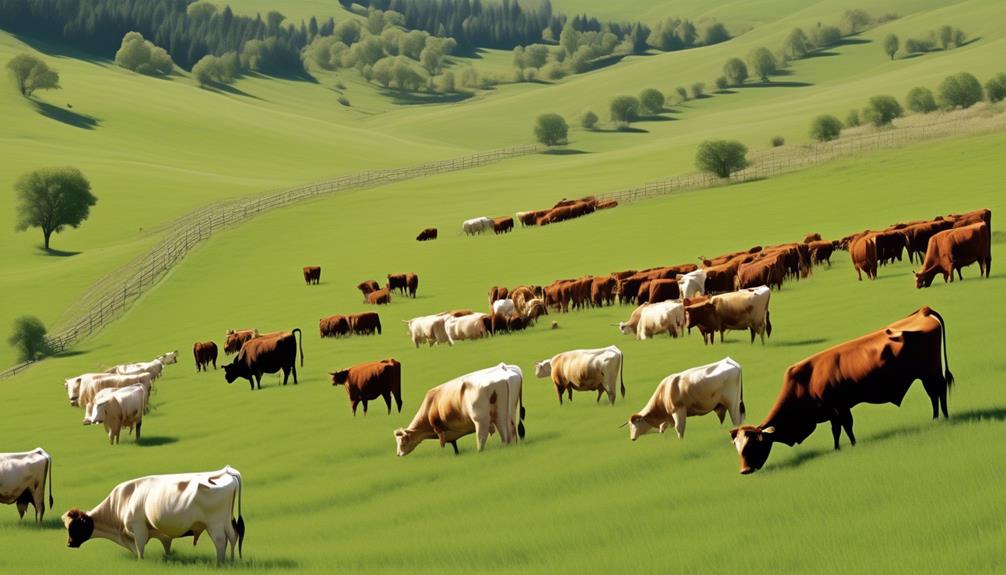
Managing your cattle ranch's forage throughout the changing seasons requires careful planning and strategic execution. Seasonal forage management is crucial for ensuring that your cattle have access to high-quality nutrition year-round.
One effective strategy for seasonal forage management is rotational grazing. By dividing your pastures into smaller paddocks and rotating the cattle through them, you can prevent overgrazing and promote more even forage utilization. This method also allows forage to recover in between grazing periods, leading to healthier pastures and improved overall productivity.
Pasture diversity is another key aspect of seasonal forage management. Different forage species thrive in different seasons, so having a diverse mix of grasses, legumes, and forbs in your pastures can provide a continuous supply of nutritious forage throughout the year.
For example, cool-season grasses such as ryegrass and fescue are excellent for early spring grazing, while warm-season grasses like Bermuda grass and switchgrass can sustain your cattle through the hot summer months. Legumes such as clover and alfalfa can enrich the pastures with nitrogen, benefitting both the forage and the soil.
Proper seasonal forage management not only supports the health and well-being of your cattle but also contributes to the overall sustainability of your ranching operation. By implementing rotational grazing and maintaining pasture diversity, you can optimize forage utilization, improve soil health, and ultimately enhance the productivity of your cattle ranch.
Best Practices for Forage Production
To optimize your cattle ranch's forage production, implementing best practices is essential for maintaining high-quality nutrition year-round. By maximizing yield, maintaining soil fertility, implementing crop rotation, and effectively managing weeds, you can ensure the continuous production of high-quality forage for your cattle.
- Maximizing Yield: Implementing proper irrigation, fertilization, and harvesting techniques can significantly increase the yield of your forage crops. Utilizing high-quality seeds and selecting suitable forage species for your specific region can also contribute to maximizing yield.
- Soil Fertility: Conducting regular soil tests and applying the appropriate nutrients based on the results are crucial for maintaining soil fertility. Implementing sustainable practices such as composting and cover cropping can also enhance the overall health and fertility of the soil.
- Crop Rotation and Weed Management: Implementing a strategic crop rotation plan can help prevent soil degradation and reduce the prevalence of pests and diseases. Additionally, effective weed management practices such as mowing, tilling, and utilizing natural weed suppressants can help maintain the integrity of your forage crops.
Incorporating these best practices into your forage production strategy won't only ensure a consistent supply of high-quality forage for your cattle but also contribute to the overall sustainability and productivity of your cattle ranch.
Frequently Asked Questions
What Specific Biodynamic Preparations Are Used in the Production of Biodynamic Forage?
You use biodynamic preparations to enhance soil fertility, ensuring high-quality forage for your cattle. These preparations include cow manure, quartz, and herbs, resulting in improved taste and palatability of the forage, benefiting your cattle's health and well-being.
How Does Biodynamic Forage Compare to Conventional Forage in Terms of Taste and Palatability for Cattle?
When it comes to taste comparison, biodynamic forage is often preferred by cattle due to its rich, diverse flavors. Additionally, it offers nutritional benefits, providing a more varied and balanced diet for your livestock.
Are There Any Specific Challenges or Obstacles in Transitioning to Biodynamic Forage Production for Cattle Ranchers?
Transitioning to biodynamic forage for cattle ranching poses challenges like adjusting to new farming methods, understanding biodynamic principles, and managing the transition period. Incorporating biodynamic practices into your operation requires careful planning and dedication.
Can Biodynamic Forage Production Have an Impact on Reducing the Need for Supplemental Feed for Cattle?
By transitioning to biodynamic forage production, you can significantly reduce the need for supplemental feed for cattle. This not only lowers costs but also has a positive environmental impact by promoting sustainable and natural feeding practices.
What Research or Studies Have Been Conducted to Demonstrate the Long-Term Benefits of Biodynamic Forage on Cattle Ranching Operations?
Research studies have demonstrated the long-term benefits of biodynamic forage on cattle ranching operations. It shows a significant impact, reducing the need for supplemental feed and improving overall herd health and productivity.
Conclusion
So, if you want to improve your cattle ranching operation, consider the benefits of biodynamic forage.
By focusing on soil health, nutritional value, and sustainable grazing practices, you can enhance the well-being of your cattle and reduce your environmental impact.
With proper seasonal forage management and best practices for forage production, you can ensure that your cattle are receiving the best possible nutrition and support for their overall health and productivity.
